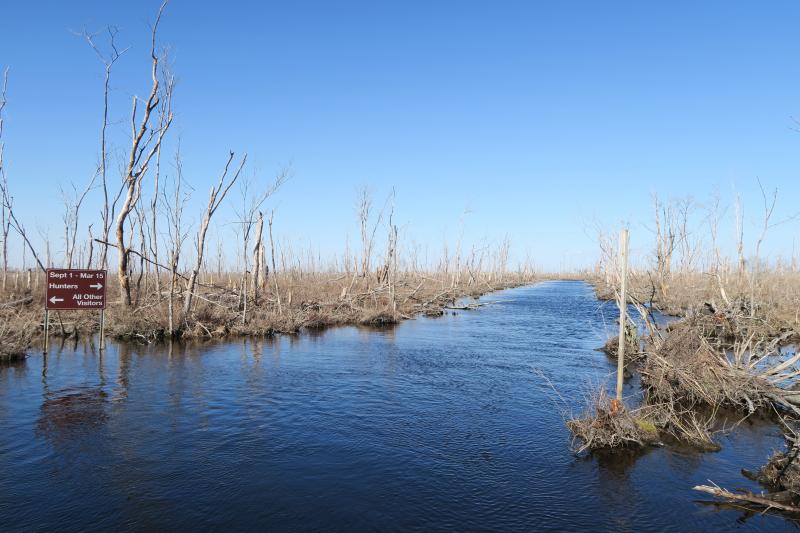Annual grasses feeding variety of Prime Hook birds

At Prime Hook National Wildlife Refuge, local farmers used to till, plant and harvest many of the fields there. Now nature plants those same fields while the harvesting is left to a variety of birds ranging from warblers, mourning doves and vireos to Canada geese.
Warm-season grasses planted in the fields die off annually, but the heavy crop of seeds they produce not only feeds birds that forage in them, but also reseeds the fields to bring back a new spread of grasses each spring.
Lots of different rodents also feed on the seeds. Like the smaller birds that perch in the grasses to feed on seed heads, the voles and moles and mice become part of the food chain at Prime Hook that also includes hawks, eagles, buzzards and foxes. Native sunflowers planted as part of the mix and patches of clover add further to the rich natural bounty of the refuge.
It’s all part of the ongoing and evolving management plan for the more than 10,000 acres of wildlife refuge established in 1963.
In the next couple weeks, according to Refuge Manager Art Coppola, some of the refuge fields will be burned in a controlled exercise. “That helps the grasses to come back more robustly and helps get rid of invasive species that don’t produce much in the way of natural food. Some fields on Fowler Beach Road will be burned and then replanted so they can return to forest.”
The warm-season grasses are giving back habitat to many birds that have been pushed out in other areas by development and urbanization. In addition to food, the grasses also provide cover that helps maintain balance between prey and predator. ‘I’ve been hearing bobwhite quail up here recently,” said Coppola. “We’re hoping for a resurgence of them.”
People enjoy trails
People can also enjoy the natural habitat at Prime Hook. Coppola said more than seven miles of trails give the public access to the woods, ponds, fields, marshes and meadows of the refuge. “Our trails are in pretty good shape, but I’m hoping to get some Conservation Corps students up here this year to make improvements,” he said.
The trails beckoned last Sunday afternoon when the sun came out and brought warmth to this chilly March we’re having. We saw magnificently colored shovelers - their heads regal green and their side feathers a mix of brown and white - swimming in shallow marsh ponds. Their tails tipped in the air as they dabbled. They paid little heed to a pair of immature bald eagles wheeling overhead. When eagles decide it’s time to feed, they can take their pick and with their razor-sharp talons make short work of a duck. What’s a duck supposed to do? Or, as Alfred E. Neuman of Mad Magazine fame would say: “What, me worry?”
At Foord’s Landing, off the Blue Goose Trail, canoeists and kayakers can launch into the brackish waters of Prime Hook Creek. To the west, the creek grows increasingly fresh; to the east, saltier. “You can see the line where the vegetation changes,” said Coppola. “In years when there’s lots of rain, the line moves down the creek. In drier years like we’ve been having recently, it moves up the creek.”
Prime Hook Creek collects freshwater from inland Sussex north and west of Milton. It flows into the refuge marshes. There used to be great expanses of freshwater marshes in that area of the refuge, but when numerous storms stoved breaches into the marsh system’s protective beaches, saltwater flooded in.
The result of that saltwater is clearly evident at Foord’s Landing. Across from the launching ramp, stands of trees that used to survive with wet feet on the fresh water have now died.
Since a massive marsh restoration program is converting that former freshwater marsh to salt, those stands of trees and related wild shrubs won’t return.
Coppola, a graduate of University of Maryland’s natural resources management program, enjoys his work. “It’s a great job, a great career, and multifaceted,” he said. “I interact with hunters, birdwatchers, hikers, fishermen - all kinds of people who like to be outdoors and who want to enjoy wildlife.”
And the good news is that people are taking advantage of the refuge.
“We had a bit of a down spike during the marsh and beach restoration project because areas had to be closed, but since then, all in all, there’s much more visitation now than in the past.”
















































